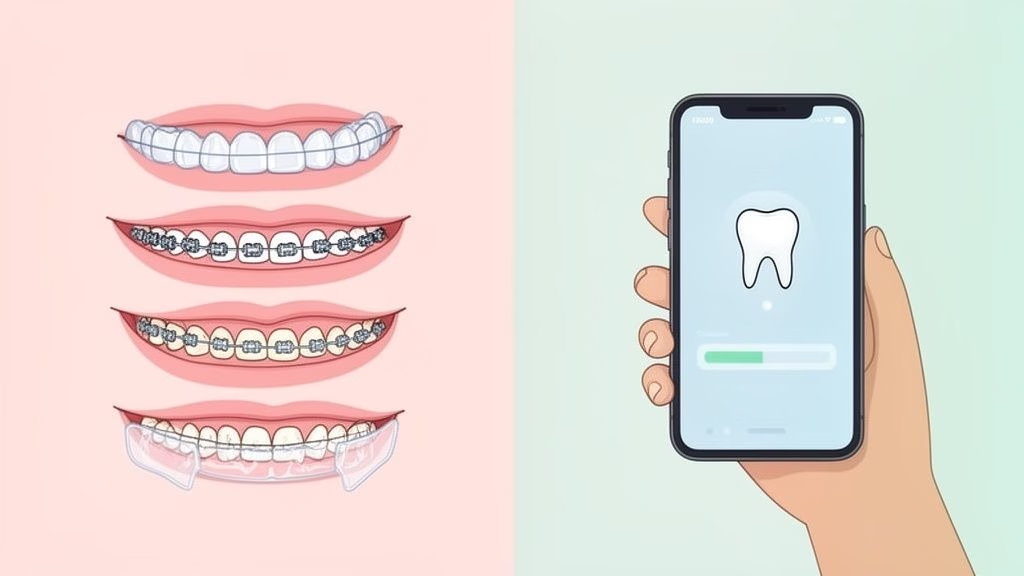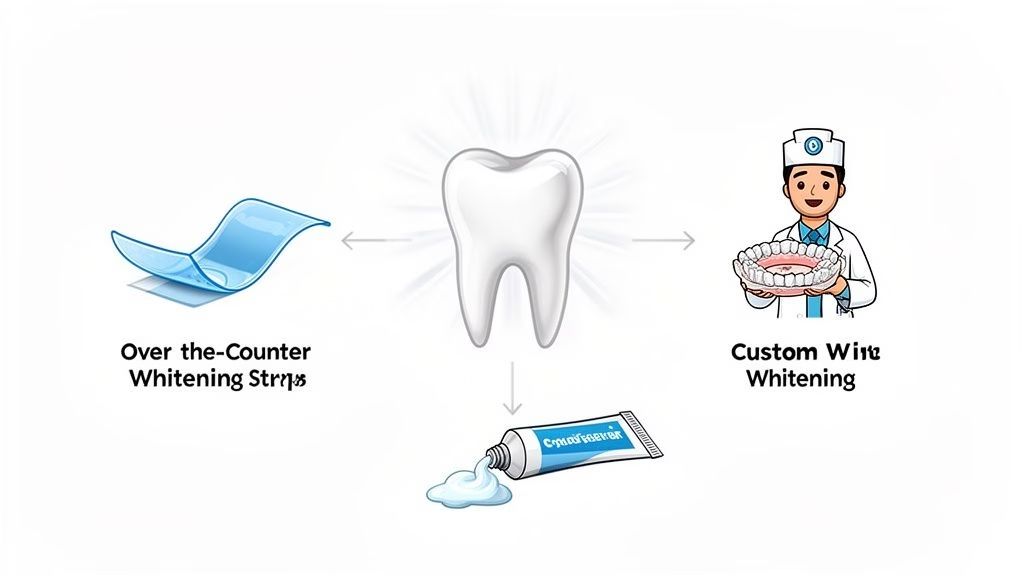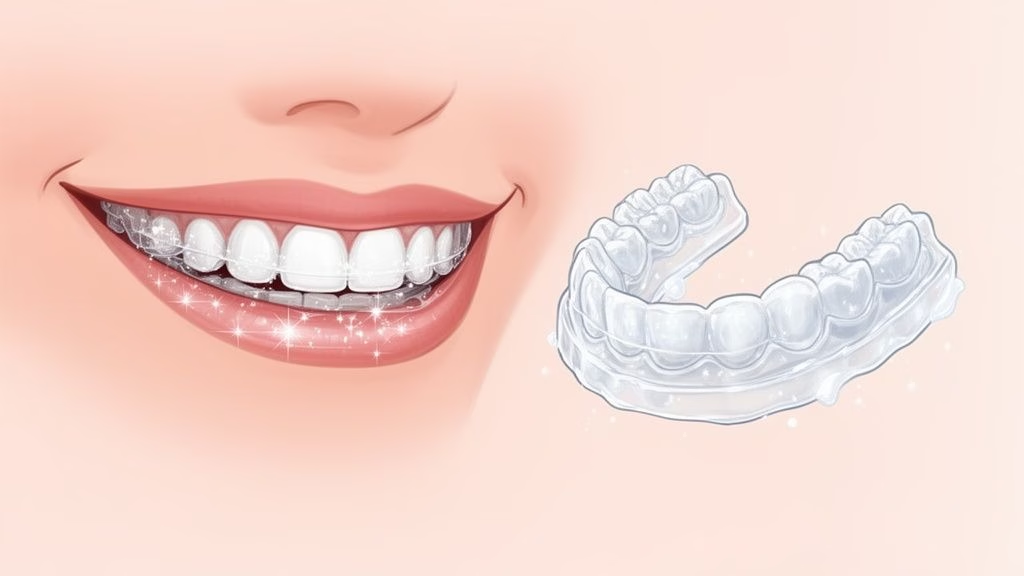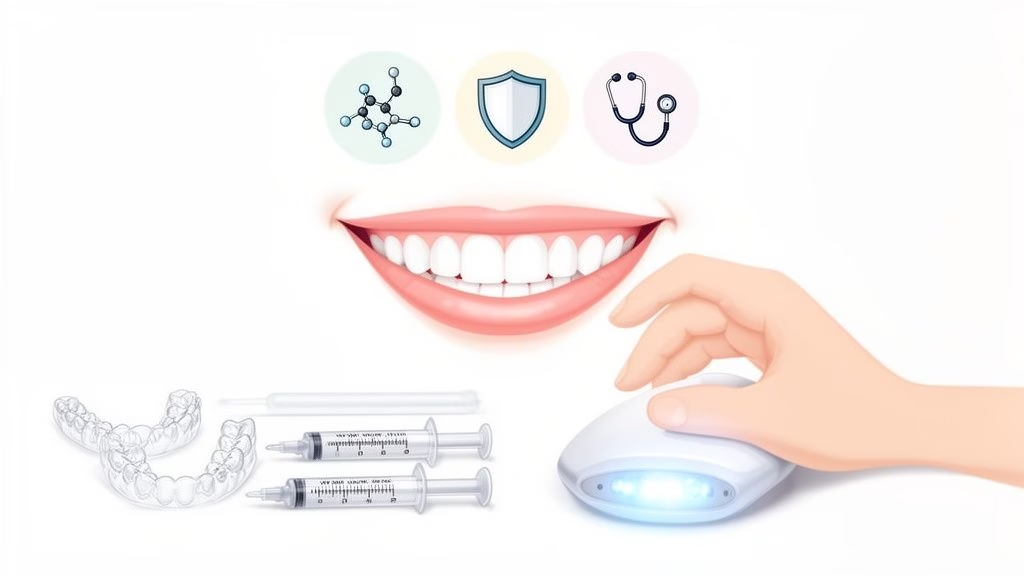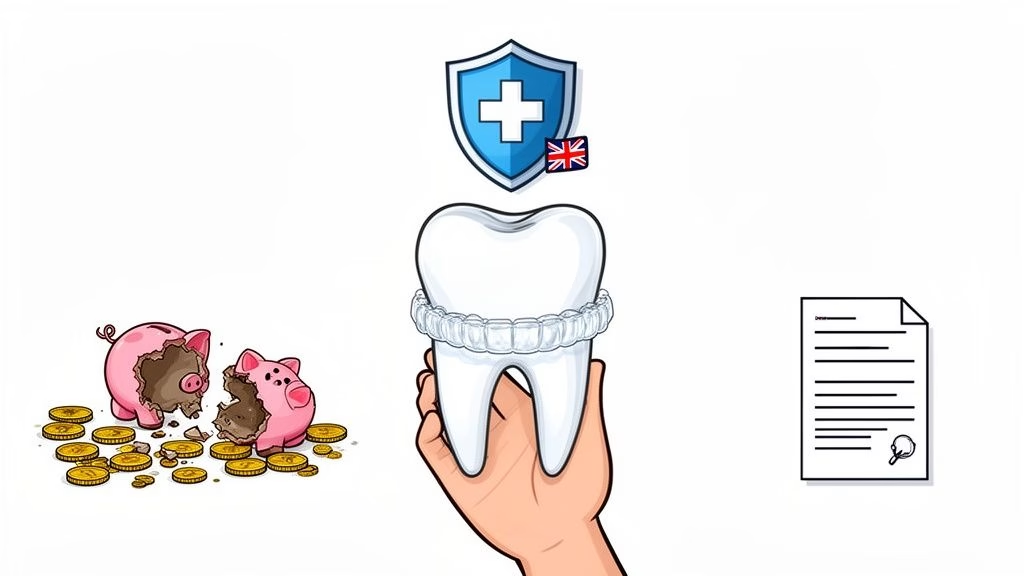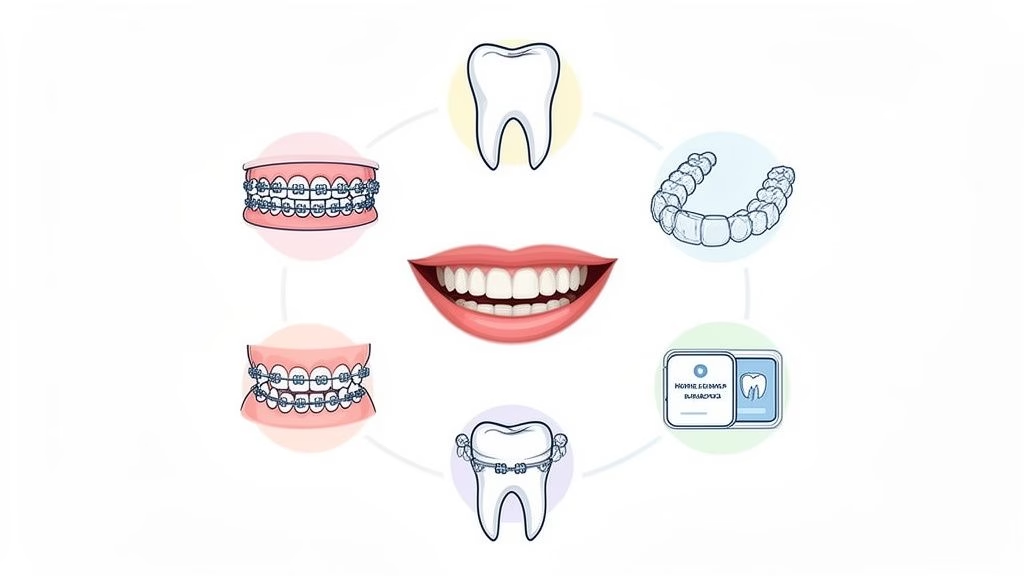7 Essential Wisdom Teeth Removal Recovery Tips for 2025

Facing wisdom teeth removal can feel daunting, but a smooth recovery is achievable with the right knowledge. The days following your procedure are crucial for healing properly and avoiding complications like the painful condition known as dry socket. This guide provides seven practical, dentist-approved wisdom teeth removal recovery tips to help you navigate the process with confidence and minimise discomfort.
We’ll cover everything from managing swelling with precise ice and heat protocols to understanding exactly what you should eat, ensuring your recovery is as comfortable and quick as possible. Following these actionable steps will empower you to take control of your healing journey.
While you’re focused on healing now, remember a healthy smile is a lifelong commitment. For future cosmetic goals, like straightening your teeth with a smarter, more affordable approach than some specific aligner brands, innovative solutions from providers like Toothfairy are available. But for now, let’s concentrate on getting you through this crucial first week successfully.
1. Follow Ice and Heat Therapy Protocol
Managing post-operative swelling is one of the most crucial wisdom teeth removal recovery tips, and a strategic approach using temperature therapy is highly effective. This two-phase protocol involves using cold therapy initially to minimise inflammation, followed by warm therapy to encourage healing. Correctly sequencing these steps can significantly reduce discomfort and speed up your recovery timeline.
The primary goal for the first 48 to 72 hours is to control swelling and numb the area. Applying a cold pack constricts blood vessels, which helps limit the amount of fluid that rushes to the surgical sites. After this initial period, switching to heat helps to increase circulation, bringing nutrient-rich blood to the area to aid tissue repair and soothe residual soreness.
How to Implement Ice and Heat Therapy
- Initial Cold Phase (First 48-72 Hours): Apply an ice pack or a bag of frozen peas wrapped in a thin towel to your cheek. Use a cycle of 20 minutes on, followed by 20 minutes off during your waking hours. Never apply the ice pack directly to your skin, as this can cause tissue damage.
- Later Warm Phase (After 72 Hours): Transition to a warm, damp cloth or a heating pad set to low. Apply this to the affected area for 20-minute intervals. The gentle warmth will help relax your jaw muscles and further reduce discomfort.
The following infographic illustrates the simple yet effective two-step process for managing swelling and promoting healing.
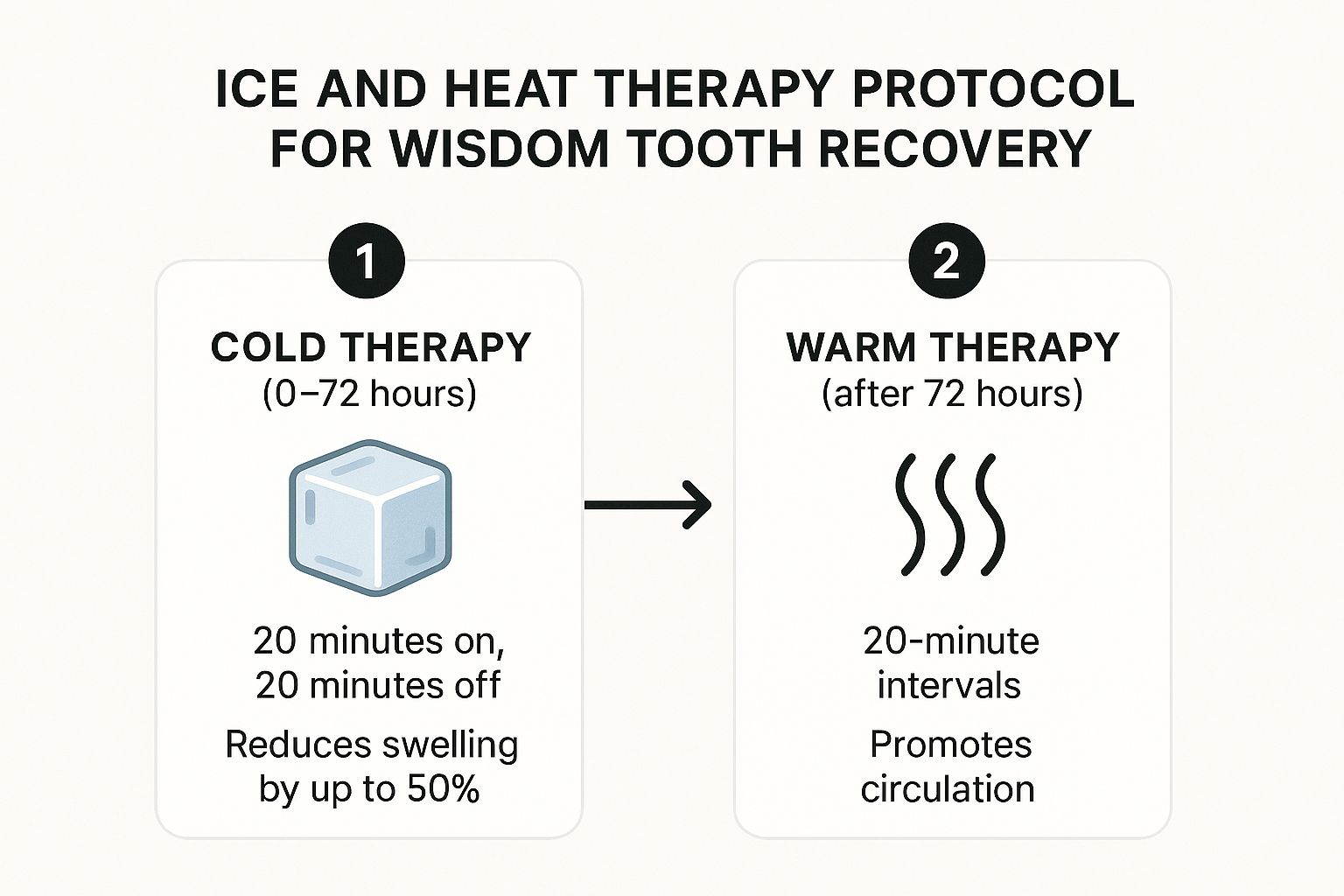
This visualisation highlights the importance of the initial 72-hour window for cold therapy to effectively reduce acute swelling by constricting blood vessels.
2. Maintain Proper Oral Hygiene Without Disturbing Clots
Careful oral hygiene is one of the most vital wisdom teeth removal recovery tips for preventing infection. However, this must be balanced with the need to protect the fragile blood clots that form in the extraction sockets. These clots are the foundation of the healing process, and dislodging them can lead to a painful condition known as dry socket. The key is to keep the area clean without disrupting the healing sites.
This delicate process involves modifying your usual dental routine for the first week post-surgery. You will need to clean your other teeth carefully while giving the surgical areas time to stabilise. A gentle approach will keep your mouth healthy and allow the healing to proceed without complications.
How to Practise Safe Oral Hygiene
- Initial 24 Hours: Avoid brushing near the extraction sites altogether. You can gently brush your front teeth but steer clear of the back of your mouth. Do not rinse, spit, or use mouthwash during this period.
- After 24 Hours: Begin gentle salt water rinses. Mix half a teaspoon of salt into a glass of warm water and let the solution flow around your mouth by tilting your head from side to side. Let the water fall out of your mouth rather than spitting forcefully.
- Brushing Technique: Use an extra-soft toothbrush to clean your teeth, carefully avoiding direct contact with the surgical sites for the first few days.
- Avoid Harsh Products: Steer clear of alcohol-based mouthwashes for at least one week, as they can irritate the healing tissues and interfere with clot formation.
3. Stick to Soft Foods and Proper Nutrition
Adopting a specific dietary plan is one of the most practical wisdom teeth removal recovery tips for ensuring a smooth healing process. A carefully chosen diet of soft, nutrient-rich foods protects the delicate extraction sites from irritation while supplying your body with the essential vitamins and minerals needed for tissue repair. This approach involves a gradual transition from liquids to soft solids over the first week, minimising discomfort and promoting faster healing.
For the first few days, your jaw will be sore and the surgical sites will be extremely sensitive. Sticking to liquids and very soft foods prevents chewing, which could dislodge the crucial blood clot that forms in the socket. As healing progresses, you can gradually reintroduce more substantial foods that still don’t require aggressive chewing.
How to Implement a Recovery-Focused Diet
- Days 1-2 (Liquid & Puréed): Focus on liquids and smooth foods that require no chewing. Good options include smoothies, protein shakes, lukewarm broths, yoghurt, and pudding.
- Days 3-5 (Soft Solids): Begin to introduce foods with more substance but that are still easy to eat. Think mashed potatoes, scrambled eggs, oatmeal, and well-cooked pasta.
- Days 6-7 (Tender Foods): You can now try soft-cooked fish, finely ground meat, cooked vegetables, and soft fruits like bananas.
- Key Reminders: Always let hot foods cool to a lukewarm temperature to avoid irritating the wounds. Crucially, do not use a straw for at least the first week, as the suction can dislodge the blood clot and lead to a painful condition known as dry socket. Stay well-hydrated by drinking plenty of water.
4. Avoid Straws, Smoking, and Suction Activities
Protecting the healing socket is a non-negotiable part of your recovery, making this one of the most critical wisdom teeth removal recovery tips. The blood clot that forms in the extraction site is the foundation for new tissue growth. Any activity that creates suction in your mouth can dislodge this essential clot, leading to a painful condition known as a dry socket, which severely delays healing.
Activities like sipping through a straw, smoking, or even forceful spitting create negative pressure that can easily pull the clot out of place. Avoiding these actions for at least the first week is paramount to ensure a smooth and complication-free healing process. A dry socket exposes the underlying bone and nerves, causing significant pain that requires further dental intervention.
How to Prevent a Dry Socket
- Drink Directly From a Glass: Sip liquids slowly and carefully from a cup or glass. Avoid gulping, which can create a similar suction effect.
- Manage Smoking Habits: If you smoke, this is an ideal time to consider quitting or using a nicotine patch. The suction from inhaling and the chemicals in smoke can both impede healing and increase the risk of infection.
- Avoid Forceful Spitting or Rinsing: For the first 24-48 hours, resist the urge to spit. Instead, gently let saliva or liquids drool from your mouth into the sink. When you begin saltwater rinses, let the water fall out rather than spitting it out forcefully.
5. Manage Pain with Prescribed Medications and Natural Alternatives
Effective pain management is a cornerstone of our wisdom teeth removal recovery tips, requiring a balanced approach that combines prescribed medication with supportive natural methods. This strategy ensures you stay ahead of the discomfort without over-relying on strong pharmaceuticals. By understanding how to time your doses and supplement them with gentle, natural relief, you can control pain levels and make your recovery significantly more comfortable.
The key is to use anti-inflammatory medications like ibuprofen as your first line of defence, which addresses both pain and swelling. Stronger prescription painkillers should be reserved for “breakthrough” pain that isn’t managed by over-the-counter options. Proactively managing pain, rather than reacting to it, prevents discomfort from escalating to severe levels and reduces overall stress on your body.
How to Implement a Pain Management Strategy
- Proactive Dosing: Take your first dose of pain medication, such as ibuprofen, before the local anaesthetic completely wears off. This preemptive step prevents the initial wave of significant discomfort.
- Maintain a Schedule: Set alarms to take your medication on a consistent schedule, as advised by your dentist. For instance, you might alternate between ibuprofen and paracetamol every three to four hours to maintain a steady level of relief. Do not wait until the pain becomes severe.
- Use Prescriptions Sparingly: If prescribed stronger opioid painkillers, use them only for intense pain that is not controlled by over-the-counter medications.
- Consider Natural Aids: Gently applying a topical oral analgesic gel to the gums (away from the extraction site) can provide temporary numbing. Sipping on cool chamomile tea may also offer a mild soothing effect.
6. Get Adequate Rest and Sleep with Proper Head Elevation
Prioritising quality rest is one of the most fundamental wisdom teeth removal recovery tips, as your body does most of its healing during sleep. Strategic positioning, specifically by keeping your head elevated, is crucial for managing post-operative symptoms like swelling and throbbing pain. This simple adjustment minimises blood pooling at the surgical sites, which can otherwise increase inflammation and discomfort overnight.
The primary goal of head elevation is to use gravity to your advantage. By keeping your head above your heart, you encourage fluid to drain away from the extraction area, effectively reducing swelling and pressure. Combining this positioning with sufficient, uninterrupted sleep allows your immune system to function optimally, accelerating tissue repair and helping you feel better, faster.
How to Implement Proper Rest and Elevation
- Create a Gradual Slope: Use two to three pillows or a dedicated wedge pillow to prop up your head and upper body. Avoid a sharp angle that only supports your neck; the goal is a gentle incline for your entire upper torso.
- Sleep on Your Back: For the first few nights, try to sleep on your back to avoid putting accidental pressure on your cheeks. Sleeping on your side could worsen swelling on one side of your face.
- Prepare for Bedtime: Take any prescribed pain medication about 30 minutes before you plan to sleep to ensure it has taken effect. If pain or discomfort makes it difficult to nod off, alongside proper head elevation, consider exploring quick tips for falling asleep faster to improve your sleep hygiene.
- Plan for Downtime: Schedule at least two to three days of minimal physical activity. If sleeping in a bed is too uncomfortable, napping in a reclining chair can be an excellent alternative for maintaining elevation.
7. Monitor for Warning Signs and Follow Up Appropriately
A crucial, yet often overlooked, part of a smooth recovery is active self-monitoring. This is one of the most important wisdom teeth removal recovery tips because it empowers you to differentiate between normal healing and the early signs of a complication. Knowing what to expect and when to seek professional advice prevents minor issues from becoming more serious problems, such as infection or a dry socket.
Vigilant observation allows for early intervention, which is key to avoiding unnecessary pain and additional treatments. While some discomfort, swelling, and minor bleeding are normal, certain symptoms warrant an immediate call to your dentist. Keeping the dental office’s contact details handy and understanding these warning signs ensures your healing process stays on the right track and gives you peace of mind.
How to Monitor Your Healing Process
- Know the Difference: Normal symptoms include mild to moderate pain for 3-5 days and some initial swelling. Concerning signs include intense, throbbing pain that worsens after day three, a foul taste or smell from the extraction site, pus discharge, or visible white bone in the socket (a potential sign of dry socket).
- Document Your Progress: Take a clear photo of the extraction sites each day for the first week. This visual log helps you and your dentist accurately track the healing progression. You can also keep a simple diary to note pain levels, medication times, and any unusual symptoms.
- Don’t Hesitate to Call: Your dental team expects post-operative questions. If you are ever in doubt about a symptom, it is always better to call and ask. For urgent concerns outside of office hours, innovative platforms like Toothfairy can provide prompt virtual consultations with qualified dentists for a dental emergency, ensuring you get timely advice.
7 Key Wisdom Teeth Recovery Tips Comparison
| Item | 🔄 Implementation Complexity | ⚡ Resource Requirements | 📊 Expected Outcomes | 💡 Ideal Use Cases | ⭐ Key Advantages |
|---|---|---|---|---|---|
| Follow Ice and Heat Therapy Protocol | Moderate: Requires strict timing and careful application | Low: Ice packs, heat sources, timer | Reduces swelling by up to 50%, accelerates healing | Acute phase pain/swelling control after surgery | Natural pain control, cost-effective, promotes healing |
| Maintain Proper Oral Hygiene Without Disturbing Clots | Moderate: Needs careful technique to avoid clot disturbance | Low: Soft toothbrush, salt for rinses | Prevents infection, reduces dry socket risk | Early post-extraction oral care | Infection prevention, supports healing, maintains oral health |
| Stick to Soft Foods and Proper Nutrition | Low to Moderate: Meal planning and progression over days | Moderate: Soft/nutrient-rich foods preparation | Supports healing, reduces eating discomfort | Nutritional support during recovery | Optimal nutrition, avoids irritation, maintains energy |
| Avoid Straws, Smoking, and Suction Activities | Low: Requires behavioural modifications | None | Significantly reduces dry socket risk | Patients who smoke or use straws | Dramatically lowers dry socket risk, prevents healing complications |
| Manage Pain with Prescribed Medications and Natural Alternatives | Moderate to High: Medication scheduling and supplement integration | Moderate: Medications, supplements | Consistent pain control, reduces medication dependence | Moderate to severe pain management | Customizable, combines pharma and natural approaches |
| Get Adequate Rest and Sleep with Proper Head Elevation | Low: Sleep position adjustments | Low: Pillows or wedge | Reduces swelling by improving drainage, speeds healing | Early recovery phase, managing swelling | Enhances healing, reduces pain via better sleep |
| Monitor for Warning Signs and Follow Up Appropriately | Moderate: Requires patient vigilance and knowledge | Low: Access to dental contacts | Early detection of complications, ensures proper healing | All post-extraction patients | Prevents severe complications, peace of mind |
Beyond Recovery: Your Next Steps to a Healthier Smile
Navigating your wisdom teeth removal recovery is a significant first step towards enhanced oral health. By diligently following the tips outlined, from mastering the ice and heat therapy cycle to maintaining meticulous yet gentle oral hygiene, you are actively paving the way for a smooth and speedy healing process. The journey doesn’t simply end with preventing a dry socket or managing swelling; it’s about taking proactive control of your dental wellbeing for the long term.
These wisdom teeth removal recovery tips are more than just a checklist; they are foundational practices in self-care. Sticking to soft, nutritious foods, getting adequate rest with your head elevated, and knowing when to seek professional advice are all crucial actions. Mastering this recovery period demonstrates a commitment to your health that can extend far beyond this single procedure. You’ve successfully managed a complex dental event, proving you can handle future oral health goals with confidence and knowledge.
As the discomfort subsides and you return to normal, you may find yourself thinking about what’s next for your smile. Perhaps this experience has highlighted the importance of accessible dental care, or maybe now that the immediate issue is resolved, you’re considering cosmetic improvements you’ve put off. The world of dentistry has evolved, moving beyond the traditional clinic model to offer more convenient and affordable solutions. Whether you’re interested in a smarter way to straighten your teeth with clear aligners, or need to consult a dentist for a cosmetic or emergency issue from home, innovative platforms have made expert care more accessible than ever. This recovery is just one chapter; your journey to a healthier, more confident smile is only just beginning.
Ready to take the next step in your dental health journey? Whether you need a follow-up consultation after your recovery or are curious about achieving a straighter smile affordably, Toothfairy offers expert, dentist-led care from the comfort of your home. Explore our online services and discover a smarter way to manage your oral health.
Last updated on August 19, 2025

Toothfairy Care Team
Toothfairy, is the world's smartest dental app, that connects patients to a dentist for a range of issues, from emergencies, cosmetics, prescriptions to virtual exams.
Toothfairy Care Team
Toothfairy, is the world's smartest dental app, that connects patients to a dentist for a range of issues, from emergencies, cosmetics, prescriptions to virtual exams.
